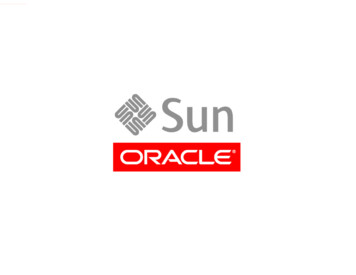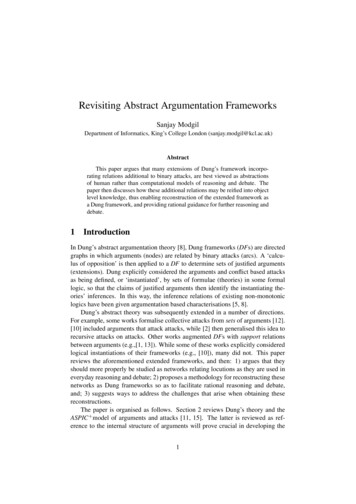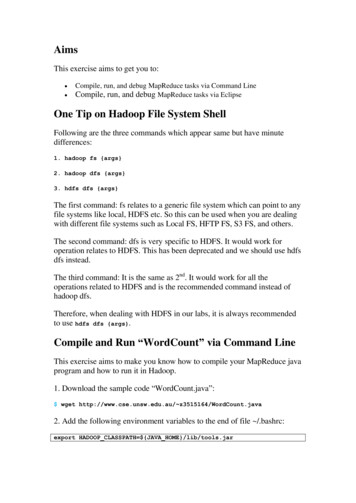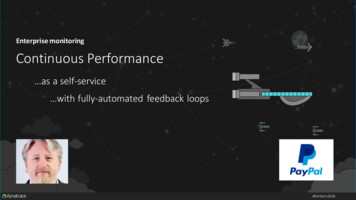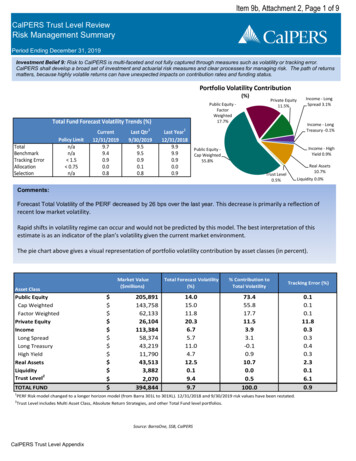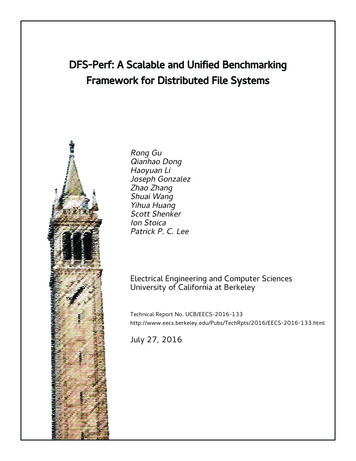
Transcription
DFS-Perf: A Scalable and Unified BenchmarkingFramework for Distributed File SystemsRong GuQianhao DongHaoyuan LiJoseph GonzalezZhao ZhangShuai WangYihua HuangScott ShenkerIon StoicaPatrick P. C. LeeElectrical Engineering and Computer SciencesUniversity of California at BerkeleyTechnical Report No. /TechRpts/2016/EECS-2016-133.htmlJuly 27, 2016
Copyright 2016, by the author(s).All rights reserved.Permission to make digital or hard copies of all or part of this work forpersonal or classroom use is granted without fee provided that copies arenot made or distributed for profit or commercial advantage and that copiesbear this notice and the full citation on the first page. To copy otherwise, torepublish, to post on servers or to redistribute to lists, requires priorspecific permission.AcknowledgementThis research is supported in part by DHS Award HSHQDC-16-3-00083,NSF CISE Expeditions Award CCF-1139158, DOE Award SN10040 DESC0012463, and DARPA XData Award FA8750-12-2-0331, and giftsfrom Amazon Web Services, Google, IBM, SAP, The Thomas and StaceySiebel Foundation, Apple Inc., Arimo, Blue Goji, Bosch, Cisco, Cray,Cloudera, Ericsson, Facebook, Fujitsu, HP, Huawei, Intel, Microsoft, Pivotal,Samsung, Schlumberger, Splunk, State Farm and VMware.
DFS-Perf: A Scalable and Unified Benchmarking Framework forDistributed File SystemsRong Gu1 , Qianhao Dong1 , Haoyuan Li2 , Joseph Gonzalez2 , Zhao Zhang2 ,Shuai Wang1 , Yihua Huang1 , Scott Shenker2 , Ion Stoica2 , Patrick P. C. Lee31National Key Laboratory for Novel Software Technology, Nanjing UniversityUniversity of California, Berkeley 3 The Chinese University of Hong Kong2Submission Type: ResearchAbstractreliable storage management. A typical DFS stripes dataacross multiple storage nodes (or servers), and also addsA distributed file system (DFS) is a key component of vir- redundancy to the stored data (e.g., by replication or eratually any cluster computing system. The performance of sure coding) to provide fault tolerance against node failsuch system depends heavily on the underlying DFS de- ures.sign and deployment. As a result, it is critical to charThere have been a spate of DFS proposals from bothacterize the performance and design trade-offs of DF- academia and industry. These proposals have inherentlySes with respect to cluster configurations and real-world distinct performance characteristics, features, and designworkloads. To this end, we present DFS-Perf, a scalable, considerations. When putting a DFS in use, users needextensible, and low-overhead benchmarking framework to decide the appropriate configurations of a wide rangeto evaluate the properties and the performance of various of design features (e.g., fine-grained reads, file backup,DFS implementations. DFS-Perf uses a highly parallel access controls, POSIX compatibility, load balance, etc.),architecture to cover a large variety of workloads at dif- which in turn affect the perceived performance and funcferent scales, and provides an extensible interface to in- tionalities (e.g., throughput, fault tolerance, security, excorporate user-defined workloads and integrate with vari- ported APIs, scalability, etc.) of the upper-layer distribous DFSes. As a proof of concept, our current DFS-Perf uted computing systems. In addition, the characteristicsimplementation includes several built-in benchmarks and of processing and storage workloads are critical to theworkloads, including machine learning and SQL applica- development and evaluation of file system implementations. We present performance comparisons of four state- tions [35], yet they often vary significantly across deployof-the-art DFS designs, namely Alluxio, CephFS, Glus- ment environments. All these concerns motivate the needterFS, and HDFS, on a cluster with 40 nodes (960 cores). of comprehensive DFS benchmarking methodologies toWe demonstrate that DFS-Perf can provide guidance on systematically characterize the performance and designexisting DFS designs and implementations, while adding trade-offs of general DFS implementations with regard to5.7% overhead.cluster configurations and workloads.1Building a comprehensive DFS benchmarking framework is non-trivial, and it should achieve two main design goals. First, it should be scalable, such that it canrun in a distributed environment to support stress-testsfor various DFS scales. It should incur low measurementoverheads in benchmarking for accurate characterization.Second, it should be extensible, such that it can easilyinclude general DFS implementations for benchmarkingfor fair comparisons. It should also support both popular and user-customized workloads to address various deployment environments.IntroductionWe have witnessed the emergence of parallel programming frameworks (e.g., MapReduce [21], Dremel [30],Spark [39, 40]) and distributed data stores (e.g., BigTable[17], Dynamo [22], PNUTS [19], HBase [6]) for enabling sophisticated and large-scale data processing andanalytic tasks. Such distributed computing systems often build atop a distributed file system (DFS) (e.g.,Lustre [16], Google File System [24], GlusterFS [26],This paper proposes DFS-Perf, a scalable and extenCephFS [37], Hadoop Distributed File System (HDFS)[33], Alluxio (formerly Tachyon) [29]) for scalable and sible DFS benchmarking framework designed for com1
Table 1: Comparison of distributed storage benchmark frameworksBenchmarkFrameworksTestDFSIO /NNBenchIORYCSBAMPLab BigData BenchmarkDFS-PerfExtend to anytargeted DFSContain workloadsfrom real worldSupport to plugin new workloadProvide app traceanalysis utilityCan run withoutcomputing frameworkSupport variousparallel modelIs aimed tobenchmark oNoYesYesNoYesNoNoYesYesYesYesYesYesYesprehensive performance benchmarking of general DFSimplementations. Table 1 summarizes the key featuresof DFS-Perf compared with existing distributed storage benchmarking systems (see Section 3 for details).DFS-Perf is designed as a distributed system that supports different parallel test modes at node, process, andthread levels for scalability. It also adopts a modulararchitecture that can benchmark large-scale deploymentsof general DFS implementations and workloads. As aproof-of-concept, DFS-Perf currently incorporates builtin workloads of machine learning and SQL query applications. Our DFS-Perf implementation is now opensourced at http://pasa-bigdata.nju.edu.cn/dfs-perf/).We first review today’s representative DFS implementations (Section 2) and existing DFS benchmarkingmethodologies (Section 3). We then make the followingcontributions.sign. Table 2 summarizes the key characteristics of thefour DFS implementations.Architecture. Alluxio, CephFS, and HDFS adopt a centralized master-slave architecture, in which a master nodemanages all metadata and coordinates file system operations, while multiple (slave) nodes store the actual filedata. CephFS and HDFS also support multiple distributed master nodes to avoid a single point of failure. Onthe other hand, GlusterFS adopts a decentralized architecture, in which all metadata and file data is scattered acrossall storage nodes through the distributed hash table (DHT)mechanism.Storage Style. CephFS, GlusterFS, and HDFS buildon disk-based storage, in which persistent block devices(e.g., hard disks). On the other hand, Alluxio is memorycentric, and uses memory as the primary storage backend.It also supports hierarchical storage which aggregates thepool of different storage resources such as memory, solidstate disks, and hard disks.Fault Tolerance. For fault tolerance, CephFS and HDFSmainly use replication to distribute exact copies acrossmultiple nodes for fault tolerance. They now also supporterasure coding for more storage-efficient fault tolerance.GlusterFS implements RAID (which can be viewed as aspecial type of erasure coding) at the volume level. Incontrast, Alluxio can leverage its under storage systems,in the meantime, it can also adopt lineage and checkpointing mechanisms to keep track of the operational history ofcomputations.I/O Optimization. All four DFSes use different strategies to improve the I/O performance. CephFS adopts acache tiering mechanism to temporarily cache the recentread and written data in memory, while GlusterFS followsa similar caching approach (called I/O cache). On theother hand, both HDFS and Alluxio enforce data locality in computing frameworks (e.g., MapReduce, Spark,etc.) to ensure that computing tasks can access data locally in the same node. In particular, Alluxio supportsexplicit multi-level caches due to its hierarchical storagearchitecture.Exposed APIs. All four DFSes expose APIs that canwork seamlessly with Linux FUSE. HDFS and Alluxioexport native APIs and a command line interface (CLI)that can work independently without third-party libraries.1. We present the design of DFS-Perf, a highly scalableand extensible benchmarking framework (Section 4)that supports various DFS implementations and bigdata workloads, including machine learning and SQLworkloads (Section 5).2. We use DFS-Perf to evaluate the performance characteristics of four widely deployed DFS implementations, Alluxio, CephFS, GlusterFS, and HDFS, andshow that DFS-Perf incurs minimal (i.e., 5.7%) overhead (Section 6).3. We report our experiences of using DFS-Perf to identify and resolve performance bugs of current DFS implementations (Section 7).2DFS CharacteristicsExisting DFS implementations are generally geared toward achieving scalable and reliable storage management,yet they also make inherently different design choices fortheir target applications and scenarios. In this section,we compare four representative open-source DFS implementations, namely Alluxio [1, 29], CephFS [37], GlusterFS [5, 26], and HDFS [7, 33]. We review their different design choices, which also guide our DFS-Perf de2
Table 2: Comparison of characteristics of Alluxio, CephFS, GlusterFS, and HDFSDFSArchitectureStorage StyleFault ToleranceI/O rchicallineage and checkpointdata locality;multi-level cachesCephFScentralized / distributeddisk-basedreplication;erasure code (optional)cache tieringGlusterFSdecentralizeddisk-basedRAID on the networkI/O cacheHDFScentralized / distributeddisk-basedreplication;erasure code (WIP)data localitySome benchmarking suites can be used to characterizethe I/O behaviors of general distributed computing systems. For example, the AMPLab Big Data Benchmark[4] issues relational queries for benchmarking and provides quantitative and qualitative comparisons of analytical framework systems, and YCSB (Yahoo Cloud ServingBenchmark) [14, 20] evaluates the performance of keyvalue cloud serving stores. Both benchmark suites areextensible to include user-defined operations and workloads with database-like schemas. The MTC (Many-TaskComputing) envelope [41] characterizes the performanceof metadata, read, and write operations of parallel scripting applications. BigDataBench [36] targets big data applications such as online services, offline analytics, andreal-time analytics systems, and provides various big dataworkloads and real-world datasets. In contrast, DFS-Perffocuses on file system operations, including both metadataand file data operations, for general DFS implementations.One design consideration of DFS-Perf is on workload characterization, which provides guidelines for system design optimizations. Workload characterization indistributed systems has been an active research topic.To name a few, Yadwadkar et al. [38] identified theapplication-level workloads from NFS traces. Chen etal. [18] studied MapReduce workloads from businesscritical deployments. Harter et al. [27] studied the Facebook Messages system backed by HBase and HDFS as thestorage layer. Our workload characterization focuses onDFS-based traces derived from real-world applications.In particular, both CephFS and Alluxio have the Hadoopcompatible APIs and can substitute HDFS for computingframeworks including MapReduce and Spark.Discussion. Because of the variations of design choices,the application scenarios vary across DFS implementations. GlusterFS, CephFS, and Lustre [13, 16] arecommonly used in high-performance computing environments. HDFS has been used in big data analytics applications along with the wide deployment of MapReduce.Alluxio provides file access at memory speed across cluster computation frameworks. The large variations of design choices complicate the decision making of practitioners when they choose the appropriate DFS solutions fortheir applications and workloads. Thus, a unified and effective benchmarking methodology becomes critical forpractitioners to better understand the performance characteristics and design trade-offs of a DFS implementation.3Exposed APIsNative API;FUSE;Hadoop Compatible API;CLIFUSE;REST-API;Hadoop Compatible APIFUSE;REST-APINative API;FUSE;REST-API;CLIRelated WorkBenchmarking is essential for evaluating and reasoningthe performance of systems. Some benchmark suites(e.g., [11, 12]) have been designed for evaluating generalfile and storage systems subject to different workloads.Benchmarking for DFS implementations has also beenproposed in the past decades, such as for single-server network file systems [15], network-attached storage systems[25], and parallel file systems (e.g., IOR [10]). Severalbenchmarking suites are designed for specific DFS implementations, such as TestDFSIO, NNBench, and HiBench[31, 8, 28] for HDFS. To elaborate, TestDFSIO specifiesread and write workloads for measuring HDFS throughput; NNBench specifies metadata operations for stresstesting an HDFS namenode; HiBench supports both synthetic microbenchmarks and Hadoop application workloads that can be used for HDFS benchmarking. Insteadof targeting specific DFS implementations, we focus onbenchmarking general DFS implementations.4DFS-Perf DesignWe present the design details of DFS-Perf. We first provide an architectural overview of DFS-Perf (Section 4.1).We then explain how DFS-Perf achieves scalability (Section 4.2) and extensibility (Section 4.3).3
SlaveLaunch slaves and Collect result gurationToolsContextWorkloadMaster1. wait allslaves setupLocal TestResultsFS Interface LayerDFS5. generateglobal reportFigure 1: DFS-Perf architecture. DFS-Perf adopts amaster-slave model, in which the master contains alauncher and other tools to manage all slaves. For eachslave, the input is the benchmark configuration, while theoutput is a set of evaluation results. Each slave runs multiple threads, which interact with the DFS via the File System Interface Layer.4.1Masterreturn localtest results2. setupwith conf3. executetest suite4. generatelocal testresultsSlaveFigure 2: DFS-Perf workflow. The master launches allslaves and distributes configurations of a benchmark toeach of them. Each slave sets up and executes the benchmark independently. Finally, the master collects the statistics from all slaves and produces a test report.can run multiple slave processes, and each slave processcan run multiple threads that execute the benchmarksindependently. The numbers of nodes, processes, andthreads can be configured by the users. Such parallelization enables us to stress-test a DFS through intensive filesystem operations.To reduce the benchmarking overhead, we only requireeach slave to issue only a total of two round-trip communications with the master, one at the beginning and one atthe end of the benchmark execution (see Figure 2). Thatis, DFS-Perf itself does not introduce any communicationto manage how each slave run benchmarks on the DFS.Thus, the DFS-Perf framework puts limited performanceoverhead on the DFS during benchmarking.DFS-Perf ArchitectureDFS-Perf is designed as a distributed architecture thatruns on top of a DFS that is to be benchmarked. It followsa master-slave architecture, as shown in Figure 1. It hasa single master process to coordinate multiple slave processes, each of which issues file system operations to theunderlying DFS. The master consists of a launcher thatschedules slaves to run benchmarks, as well as a set ofutility tools for benchmark management. For example,one utility tool is the report generator, which collects results from the slaves and produces performance reports.Each slave is a multi-threaded process (see Section 4.2)that can be deployed on any cluster node to execute benchmark workloads on a DFS.Figure 2 illustrates the workflow of executing a benchmark in DFS-Perf. First, the master launches all slavesand distributes test configurations to each of them. Eachslave performs initialization process, such as loading theconfigurations and setting up the workspace, and notifiesthe master when it completes the initialization process.When all slaves are ready, the master notifies them to startexecuting the benchmark simultaneously. Each slave independently conducts the benchmark test by issuing a setof file system operations, including the metadata and filedata operations that interact with the DFS’s master andstorage nodes, respectively. It also collects the performance results from its own running context. Finally, afterall slaves issue all file system operations, the master collects the context information to produce a test report.4.2distributeconfigurationssetup donerun test4.3ExtensibilityDFS-Perf achieves extensibility in two aspects. First,DFS-Perf provides a pluggable interface via which userscan add a new DFS implementation to be benchmarkedby DFS-Perf. Second, DFS-Perf provides an interface viawhich users can customize specific workloads for theirown applications to run atop the DFS.4.3.1Adding a DFSDFS-Perf provides a general File System Interface Layerto abstract the interfaces of various DFS implementations.Each slave process interacts through the File System Interface Layer with the underlying DFS, as shown in Figure 1.One design challenge of DFS-Perf is to support generalfile system APIs. One option is to make the File SystemInterface Layer of DFS-Perf POSIX-compliant. But DFSimplementations may not support POSIX APIs, whichare commonly used in local file systems of Linux/UNIXbut may not be suitable for high-performance parallelI/O [23]. Another option is to deploy Linux FUSE insideScalabilityTo achieve scalability, DFS-Perf parallelizes benchmarkexecutions in a multi-node, multi-process, and multithread manner: it distributes the benchmark executionthrough multiple nodes (or physical servers); each node4
DFS-Perf, as it is supported by a number of DFS implementations (see Section 2). However, Linux FUSE addsadditional overheads to distributed file system operations.Here, we carefully examine the APIs of state-of-the-artDFS implementations and classify the general file systemAPIs into four categories, which cover the most commonbasic file operations.file numbers and locations, and the I/O buffer sizes. Allconfigurations are described in XML format that can beeasily configured. Each slave process will take both thebase classes and the configuration file of a workload.Table 3: Components for a workload definition: baseclasses and a configuration file.Sub-ComponentPerfThread Session Management: managing DFS sessions, including connect and close methods; Metadata Management: managing DFS metadata, including create, delete, exists, getParent, isDirectory, isFile, list, mkdir, and rename methods; File Attribute Management: managing file attributes,such as the file path, length, and the access, create, andmodification time; File Data Management: the I/O operations that transfer the actual file data. Currently they are via InputStream and OutputStream due to the APIs provided bysupported gure.xml5To elaborate, we abstract a base class called DFS thatrealizes the interfaces of above four categories of generalDFS operations. The abstract methods of DFS constitutethe File System Interface Layer in DFS-Perf. To supporta new DFS, users only need to implement those abstractmethods in a new class that inherit the base class DFS.Users also register the new DFS class into DFS-Perf byadding an identifier (in the form of a constant number) tomap the new DFS to the implemented class. DFS-Perf differentiates the operations of a DFS implementation via aURL scheme in the form of fs://. Note that users need notbe concerned about the synchronization issues of APIs,which are handled by DFS-Perf.Take CephFS as an example. We add a new class namedDFS Ceph and implement all abstract methods for interacting with CephFS. Our implementation only comprisesless than 150 lines of Java codes. To specify file systemoperations with CephFS in a benchmark, users can specifythe operations in the form of ceph://.Our current DFS-Perf prototype has implemented thebindings of several DFS implementations, includingAlluxio, CephFS, GlusterFS, HDFS, as well as the localfile system.4.3.2MeaningThe class that contains all workloadexecution logic of a thread.The class that maintains the measurement statistics and running status.The class that keeps all threads andconducts the initialization and termination work.The class that generates the test reportfrom all workload contexts.The configuration file that managesthe workload settings in XML format.Benchmark DesignA practical DFS generally supports a variety of applications for big data processing. To demonstrate howDFS-Perf can benchmark a DFS against big data applications, we have designed and implemented built-in benchmarks for two widely used groups of big data applications, namely machine learning and SQL query applications. For machine learning, we consider two applications: KMeans and Bayes, which represent a clusteringalgorithm and a classification algorithm, respectively [9].For SQL queries, we consider three typical query applications: select, aggregation, and join [32].5.1DFS Access Traces of ApplicationsWe first study and design workloads of the five big dataapplications based on their access patterns. Tarasov etal [34] can extract workload models from large I/O traces,including I/O size, CPU utilization, memory usage, andpower consumption. However, to sufficiently reflect theperformance of applications, DFS-Perf focuses on theDFS-related traces, since these traces show how the applications interact with a DFS. Specifically, we run eachapplication on Alluxio with a customized Alluxio client,which records all operations. We then analyze the DFSrelated traces based on the output logs. In our study, theDFS-related access operations can be divided into fourcategories: sequential writes, sequential reads, randomreads, and metadata operations. The first three types ofoperations are collectively called data operations. Here, asequential read means reading a file sequentially from thehead to the end, while a random read means reading a filerandomly by skipping to different locations.Adding a New WorkloadDFS-Perf achieves loose coupling between a workloadand the DFS-Perf execution framework. Users can simplydefine a new workload in DFS-Perf by realizing severalbase classes and a configuration file, as shown in Table 3.The base classes specify the execution logic and the measurement statistics of a workload, while the configurationfile consists of the settings of a workload, such as the information about testing data sizes and distributions, the5
Pencentage100MB5%7%6%23%sequential read8050%6038%random read43%77%2056%51%23%0nkmeans bayes selectaggregatio joinsizesequential readsizerandom hmarks0040060080010001200(a) KMeans100MBsizesequential writeOperation Size / Times100KBOverview of File Operation TracesWe first analyze the access patterns of the benchmarks.We have collected file operation-related traces, and summarizes the traces of each benchmark in terms of thepercentage of read/write operation counts. Figure 3 illustrates that these workloads all issue more reads thanwrites, although they have different read-to-write ratios.The SQL query workloads have more balanced proportions of sequential reads and random reads than machinelearning workloads. Also, the aggregation application hasthe highest percentage of random reads (up to 56%), whilethe Bayes application has no random read operation at all.5.1.2200Operation Sequence Number (interval 10)Figure 3: Summary of the five applications’ DFS-relatedaccess traces. All of them issue more reads than writes,and the proportion of sequential and random read is morebalanced in SQL query applications than in machinelearning applications.5.1.1sequential write100B100MB70%40size100KBsequential writeOperation Size / Times100100B100MBsequential readsize100KB100B100MBsizerandom Operation Sequence Number (interval 10)(b) BayesFigure 4: Detailed DFS Access Traces of Machine Learning Benchmarks. (a) The KMeans training process isiterative. It reads a lot of data in each iteration and writesmore in the end. (b) The Bayes training process can be obviously divided into several sub-processes, each of whichis filled with many sequential reads and few sequentialwrites. Note that there is no random read.Machine Learning Benchmarks5.1.3We analyze the DFS access traces of the machine learningbenchmarks in detail. Figure 4 and Figure 5 show the detailed traces. The X-axis is the operation sequence number, each of which corresponds to an operation; the Y-axisis the data sizes of read and write operations, or times ofmetadata operations. For brevity, in each benchmark, wechoose an interval and measure the aggregated operationsize or times in each interval. These measurements are affected by various factors in different benchmarks, but wecan still summarize the access patterns from their trends.SQL Query BenchmarksWe now analyze the DFS access traces of the SQL QueryBenchmarks. Many big data query systems, such as Hive,Pig, and SparkSQL, convert SQL queries into a seriesof MapReduce or Spark jobs. These applications mainlyscan or filter data by sequentially reading data from a DFSin parallel. Also, they use indexing techniques to locatevalues, and hence trigger many random reads to a DFS.In Figure 5(a), we find that the select benchmark has atleast thousands of times more random reads than sequential reads. However, the result size is small and thus thereare only few sequential writes. The aggregation benchmark is more complex than the select benchmark. Asshown in Figure 5(b), the aggregation benchmark keepsreading data and executing the computation logic, and finally it writes the result to a DFS. The number of the random reads is still more than that of sequential reads. Also,there is an obvious output process due to the large size ofthe result. In Figure 5(c), the whole process of the joinbenchmark can be split into several read and write sub-Figure 4 demonstrates the DFS access traces of theKMeans and Bayes training processes. It is obvious thatthese data analytic applications access a DFS in an iterative fashion. A training process contains several iterations, each of which reads a variable size of data (ranging from several kilobytes to several gigabytes). In thelast round, the result determining the size of write operations is the output. Note that sequential reads appear muchmore frequently than random reads.6
size100MBsequential writeOperation Size / TimesOperation Size / Times100B100MBsequential readsize100KB100B100MBrandom Operation Sequence Number (interval 5)(a) Selectsize100MBsequential write100KB100KB100MBsizesequential read100KB100B100MBrandom 001200(b) Aggregationrandom readsize100KB100Btimesmetadata100400sequential read100B0Operation Sequence Number (interval 10)size100KB5200sequential write100B50size100KB100BOperation Size / Times100MB0500100015002000Operation Sequence Number (interval 10)(c) JoinFigure 5: DFS Access Traces of SQL Query Benchmarks. The random read size is always more than the sequentialread size. (a) Select: At about the halfway mark and the end of the whole process, there are sequential writes witha larger data size. (b) Aggregation: The sequential writes are concentrated at the end of the whole process. (c) Join:This is the longest process and we can obviously see two sequential write sub-processes.processes. The read sub-processes are filled with randomreads, while the write sub-processes are mixed with sequential reads and sequential writes.In summary, the SQL query benchmarks generate morerandom reads than sequential reads. In addition, the readsand writes are mixed with a certain ratio which is determined by the data size.5.2write a list of files, respectively. As the basic operationsof a file system, they are used to test the throughput of aDFS. In addition, we provide a random read workload torepresent the indexing access in databases or the searching access in algorithms. This workload randomly skipsa certain length of data and then reads another certainlength of data instead of sequentially reading the wholefile. Note that a DFS usually provides data streams forreading across the network, and thus the only way for current supported DFSes to perform random skips is to create a new input stream when skipping backward. However, DFS-Perf reserves the randomly reading interfacethat new DFS can have its own implementation. The writeworkload is to write content into new files, so it is alsothe data generator of DFS-Perf with the configurable datasizes and distributions.Mixed Read/Write Workload: In general, the read-towrite ratio varies across applications. This workload iscomposed of a mixture of read and write workloads witha configurable ratio. It resembles the real-world applications with heavy reads (e.g., hot da
ments. HDFS has been used in big data analytics appli-cations along with the wide deployment of MapReduce. Alluxio provides file access at memory speed across clus-ter computation frameworks. The large variations of de-sign choices complicate the decision making of practition-ers when they choose the appropriate DFS solutions for

